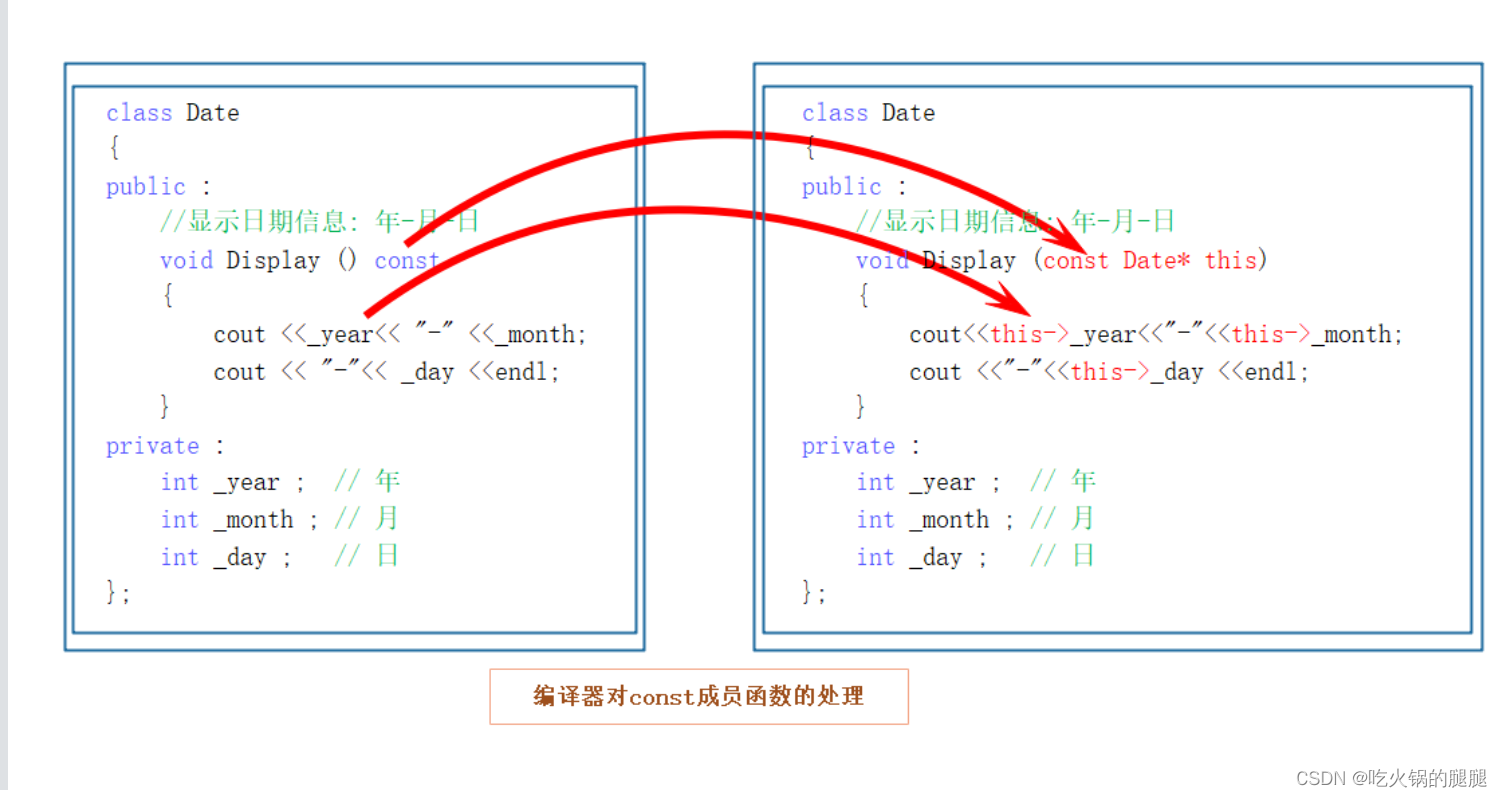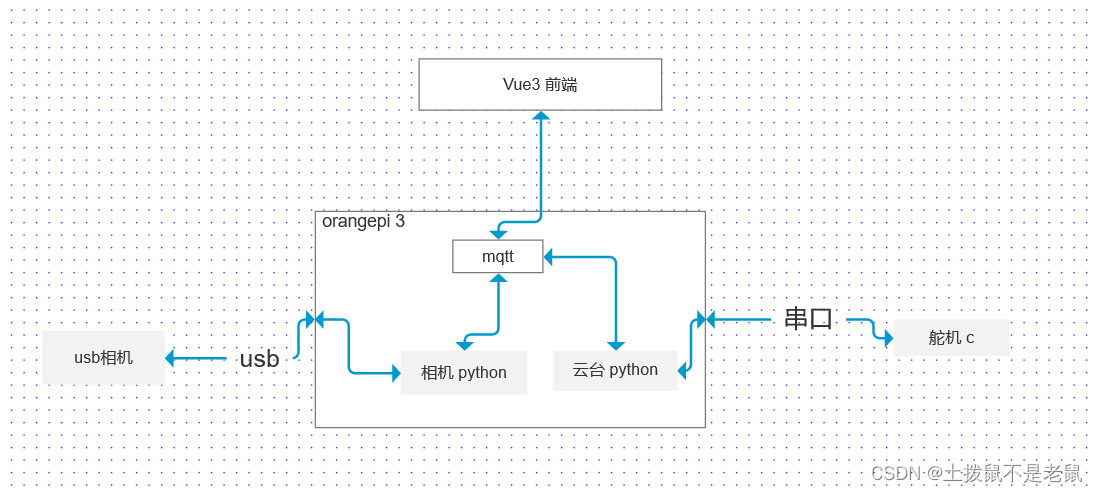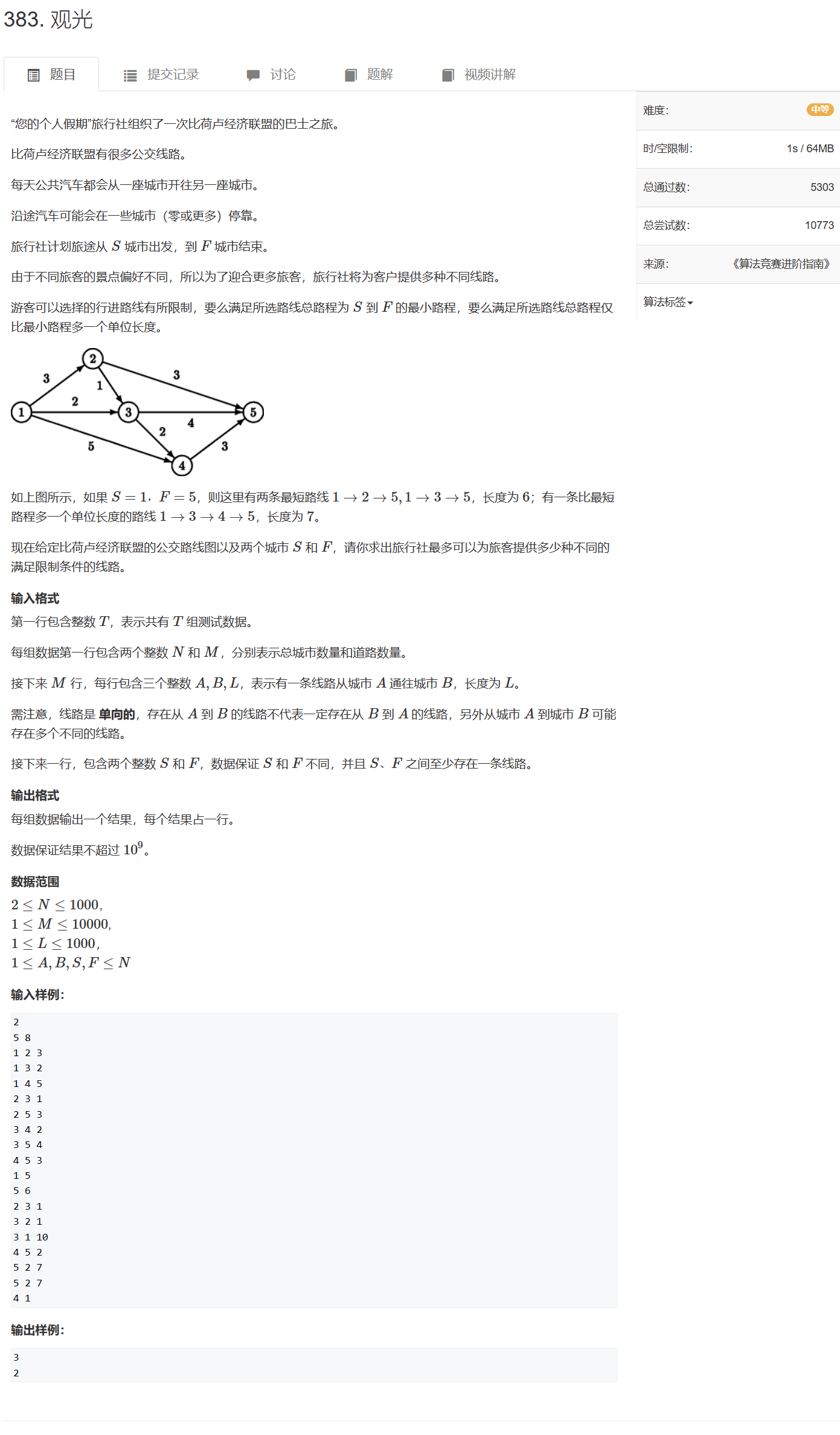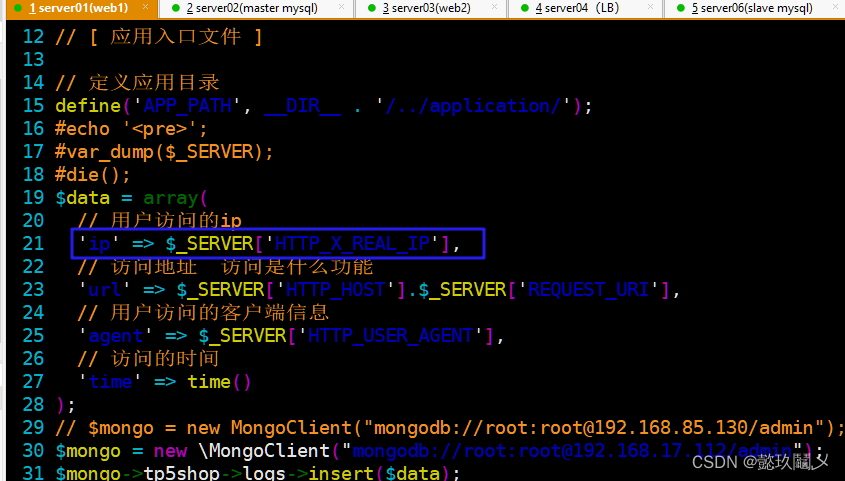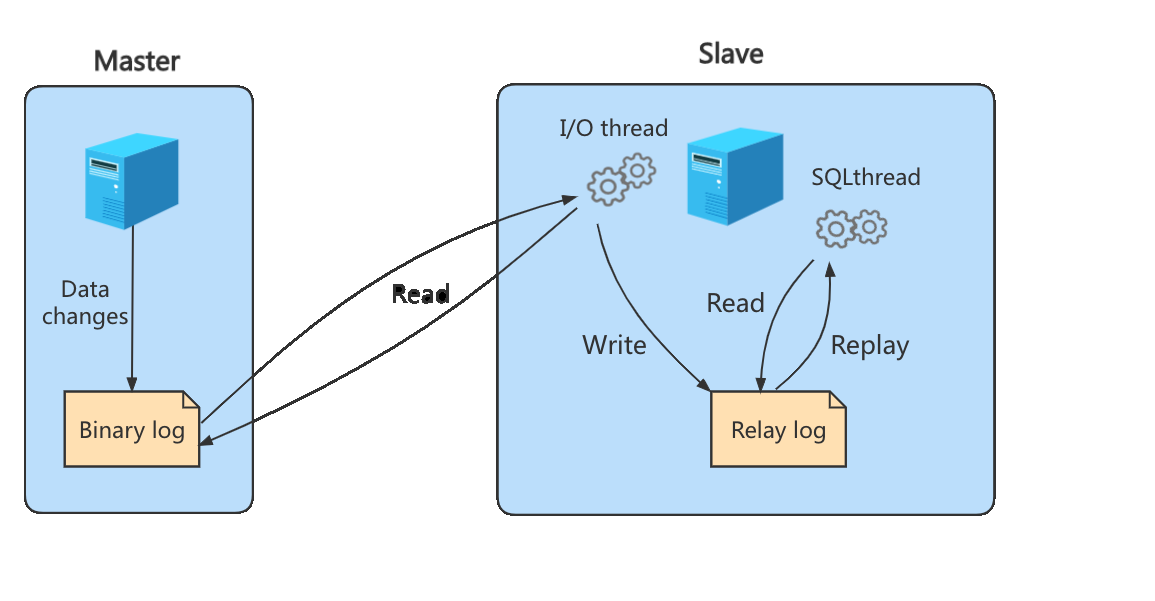离散化
定义
把无限空间中有限的个体映射到有限的空间中去,以此提高算法的时空效率。通俗的说,离散化是在不改变数据相对大小的条件下,对数据进行相应的缩小。
适用范围:数组中元素值域很大,但个数不是很多。
比如将a[]=[1,3,100,2000,500000]映射到[0,1,2,3,4]这个过程就叫离散化。
两种离散化方式
1.利用sort+unique进行数据离散化(适用于区间查找,及更新)
常与前缀和、树状数组、线段树和动态规范结合考查。
先来看一个金典题目:
题目
假定有一个无限长的数轴,数轴上每个坐标上的数都是 0。
现在,我们首先进行 n次操作,每次操作将某一位置 x 上的数加 c。
接下来,进行 m 次询问,每个询问包含两个整数 l 和 r,你需要求出在区间 [ l , r ] 之间的所有数的和。
输入格式:
第一行包含两个整数 n 和 m。
接下来 n行,每行包含两个整数 x 和 c。
再接下来 m 行,每行包含两个整数 l 和 r。
输出格式:
共 m 行,每行输出一个询问中所求的区间内数字和。
数据范围:
−109 ≤ x ≤ 109
1 ≤ n ≤ 105
1 ≤ m ≤ 105
−109 ≤ l ≤ r ≤ 109
− 10000 ≤ c ≤ 10000
输入样例
3 3
1 2
3 6
7 5
1 3
4 6
7 8
输出样例
8
0
5
思路:
由于1 ≤ n ≤ 105 和1 ≤ m ≤ 105 所调用的数字范围较小,而数轴范围较大,故可以将通过离散化处理,将−109 ≤ x ≤ 109
范围缩为 −105 ≤ x ≤ 105 左右,大大提高效率。
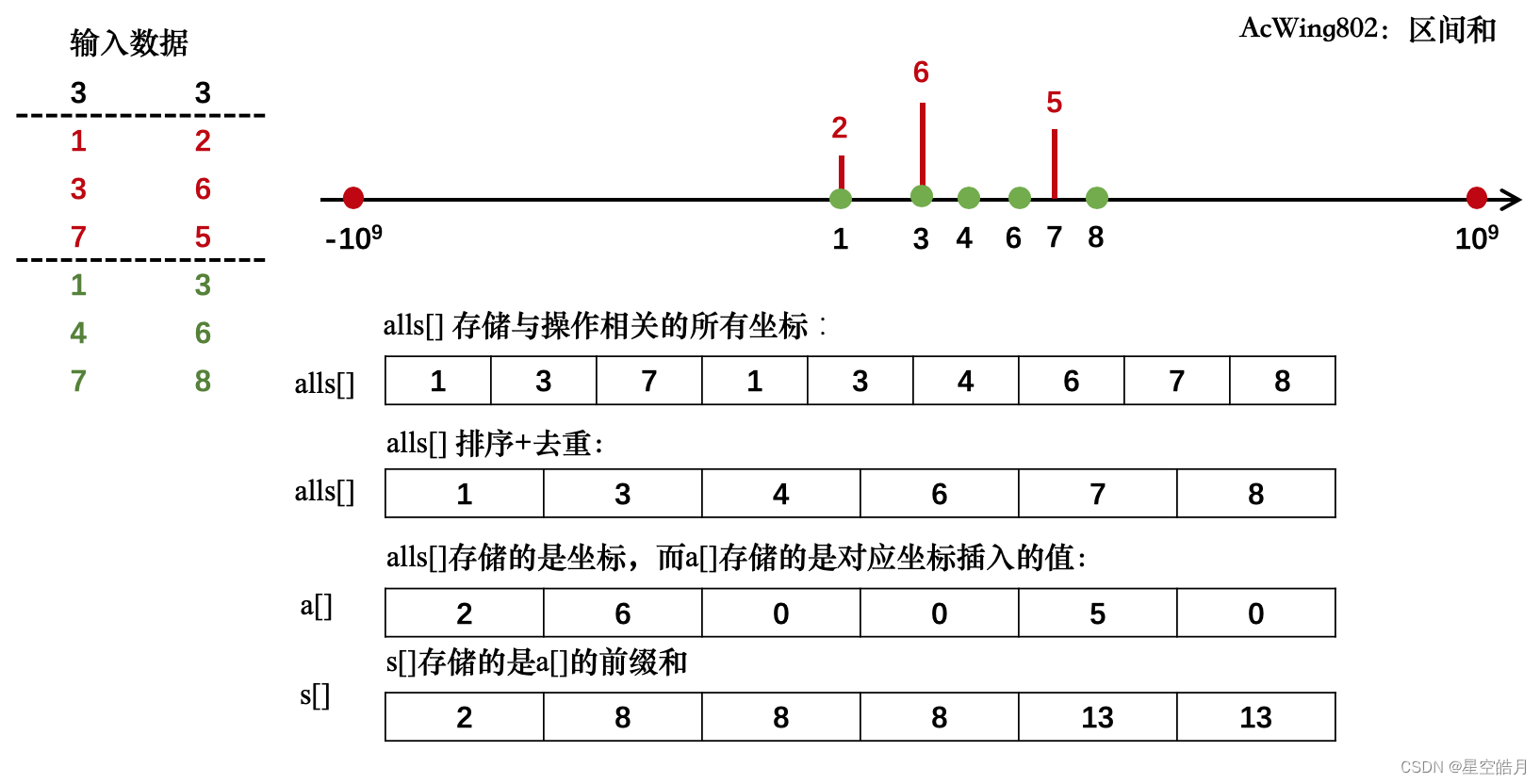
代码
#define _CRT_SECURE_NO_WARNINGS
#include<iostream>
#include<algorithm>
#include<vector>
using namespace std;
typedef pair<int, int> PII;
const int N = 3 * 1e5 + 10;
int a[N], s[N];
vector<int> alls;
vector<PII> add, query;
// 二分查找
int find(int x)
{
int l = 0, r = alls.size() - 1;
while (l < r)
{
int mid = l + ((r - l) >> 1);
if (alls[mid] >= x) r = mid;
else l = mid + 1;
}
return l + 1; // 由于S是从1开始的,所以对应映射位置都往前提一位
}
int main()
{
int n, m;
cin >> n >> m;
for (int i = 0; i < n; ++i)
{
int x, c;
cin >> x >> c;
add.push_back({x, c});
alls.push_back(x);
}
for (int i = 0; i < m; ++i)
{
int l, r;
cin >> l >> r;
query.push_back({l, r});
alls.push_back(l);
alls.push_back(r);
}
sort(alls.begin(), alls.end());
alls.erase(unique(alls.begin(), alls.end()), alls.end());
for (auto& item : add)
{
int x = find(item.first);
a[x] += item.second;
}
for (int i = 1; i <= alls.size(); ++i) s[i] = s[i - 1] + a[i];
for (auto& item : query)
{
int l = find(item.first), r = find(item.second);
cout << s[r] - s[l - 1] << endl;
}
return 0;
}
当然这里也可以用数组+lower_bound来做,下面会说
1.1 Mayor’s posters POJ - 2528
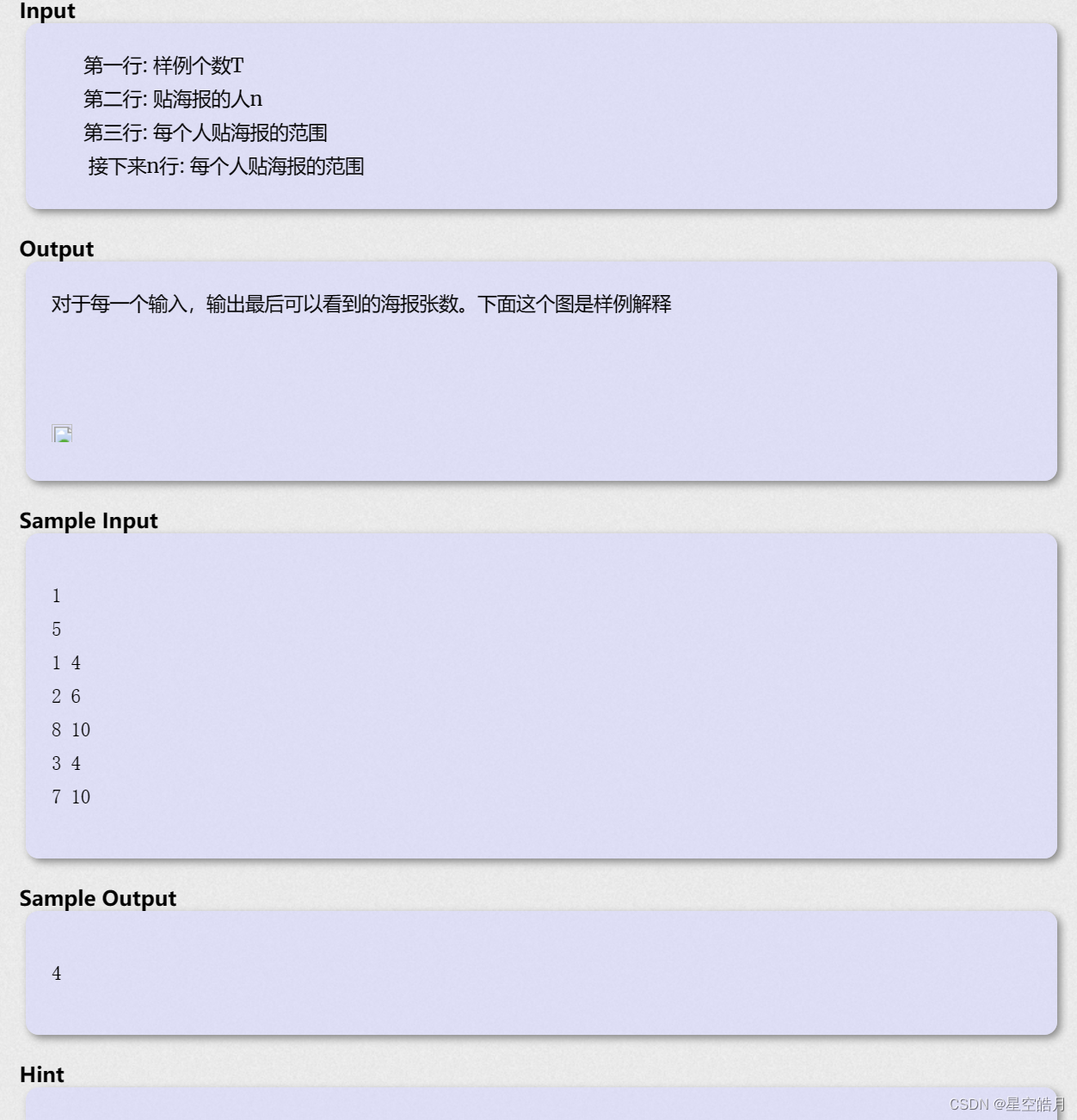
思路:
可以将问题转化为,求区间的最小值,让每个区间的海报标记为第i个放的,然后用线段树来做。
查询每个海报区间的最小值是否等于i,如果等于i则没有被完全覆盖。本题的数据量太大,区间是[1, 1e7],
所以要用离散化,存取l和r的相对大小,因为n = 1e4,所以离散过后的区间为[1, 2 * n]。
时间复杂度O(nlogn)
#include<cstdio>
#include<map>
#include<iostream>
#include<algorithm>
#define ls rt << 1, l, m
#define rs rt << 1 | 1, m + 1, r
using namespace std;
const int maxn = 2e4 + 5;
int mi[maxn << 2], a[maxn], add[maxn<<2];
struct node{
int l, r, pos;
}arr[maxn];
int n;
void pushUp(int rt){
mi[rt] = min(mi[rt << 1], mi[rt << 1 | 1]);
}
//下推标记
void pushDown(int rt){
add[rt << 1] = add[rt];
add[rt << 1 | 1] = add[rt];
mi[rt << 1] = add[rt];
mi[rt << 1 | 1] = add[rt];
add[rt] = 0;
}
//建树,此过程可用memset代替
void build(int rt, int l, int r){
if (l == r){
mi[rt] = 0;
return;
}
int m = (l + r) >> 1;
build(ls);
build(rs);
pushUp(rt);
}
//区间修改
void update(int rt, int l, int r, int L, int R, int C){
if (L <= l && r <= R){
mi[rt] = C;
add[rt] = C;
return;
}
if(add[rt] != 0) pushDown(rt);
int m = (l + r) >> 1;
if (L <= m) update(ls, L, R, C);
if (m < R) update(rs, L, R, C);
pushUp(rt);
}
//查询区间最小值
int query(int rt, int l, int r, int L, int R){
if (L <= l && r <= R){
return mi[rt];
}
if (add[rt] != 0) pushDown(rt);
int m = (l + r) >> 1;
int res = maxn;
if (L <= m) res = min(res, query(ls, L, R));
if (m < R) res = min(res, query(rs, L, R));
return res;
}
//离散化
void disc(int cnt){
sort(a, a + cnt);
int lena = unique(a, a + cnt) - a;
for (int i = 0; i < n; ++i){
arr[i].l = lower_bound(a, a + lena, arr[i].l) - a + 1;
arr[i].r = lower_bound(a, a + lena, arr[i].r) - a + 1;
// printf("l = %d r = %d\n", arr[i].l, arr[i].r);
}
}
void solve(){
scanf("%d", &n);
build(1, 1, n << 1);
int cnt = 0;
for (int i = 0; i < n; ++i){
scanf("%d%d", &arr[i].l, &arr[i].r);
arr[i].pos = i + 1;
a[cnt++] = arr[i].l;
a[cnt++] = arr[i].r;
}
disc(cnt);
for (int i = 0; i < n; ++i){
update(1, 1, n << 1, arr[i].l, arr[i].r, arr[i].pos);
}
int ans = 0;
for (int i = 0; i < n; ++i){
int x = query(1, 1, n << 1, arr[i].l, arr[i].r);
//printf("x = %d\n", x);
if (x == arr[i].pos) ans++;
}
printf("%d\n", ans);
}
int main(){
int t;
scanf("%d", &t);
for (int i = 0; i < t; ++i) solve();
return 0;
}
1.2 Mayor’s posters POJ - 2528
/*
需要计划你接下来k天的日程。在每一天里.她可以选择学习或者颓废,但是为了劳逸结合,日程表有两类限制:
1、在某个时间段中至少有一天要学习。
2、在某个时间段中至少有一天要颓废。
请问一共有多少种合法的日程表?答案对1000000007取模。
输入格式
第一行三个非负整数k,n,m,分别表示天数,至少有一天学习的时间段个数和至少有一天颓废的时间段个数。
接下来n行,每行两个正整数l,r,表示第l至第r天中至少有一天学习。
接下来m行.每行两个正整数l,r,表示第l至第r天中至少有一天颓废。
输出格式
一行一个整数,表示答案对1000000007取模后的结果。
样例输入
5 2 2
1 3
3 5
2 2
4 5
样例输出
8
以下把学习称为填黑,颓废称为填白。先离散化一下,每段有三种情况∶全黑、全白、有黑有白。
最终方案需要满足没有一个连续黑段包含完整的第二类区间,也没有一个连续白段包含完整的第一类区间。
设fi.gi,hi表示从左到右填到第i段,且结尾是黑、白、有黑有白的合法方案数,那么i这个位置往前的最长黑色、白色连续
段长度很容易求出,转移用前缀和优化一下就行了。复杂度瓶颈是离散化。
也有开两个线段树记录最后一个和末尾不同的位置的做法,但是比较难写,常数也较大,可能被卡常。
接着,我们使用动态规划来计算填黑和填白的方案数。我们用fs[i]表示以第i个时间段结尾的全填黑的方案数,ft[i]表示以第i个时间段结尾的全填白的方案数,g[i]表示以第i个时间段结尾有黑有白的方案数。
对于fs[i],我们可以根据之前的结果得到,如果第i个时间段全填黑,那么前一个时间段只能全填白或者有黑有白,所以有fs[i] = (sg[i-1] - sg[mt[i]-1] + MOD) % MOD + (st[i-1] - st[mt[i]-1] + MOD) % MOD,其中sg[i]和st[i]分别表示前i个时间段填黑和填白的方案数的前缀和,mt[i]表示以第i个时间段结尾的最短黑色时间段的左端点。
对于ft[i],同理我们有ft[i] = (sg[i-1] - sg[ms[i]-1] + MOD) % MOD + (ss[i-1] - ss[ms[i]-1] + MOD) % MOD,其中sg[i]和ss[i]分别表示前i个时间段填黑和填白的方案数的前缀和,ms[i]表示以第i个时间段结尾的最短白色时间段的左端点。
对于g[i],如果我们在第i个时间段结尾填黑,那么前i-1个时间段可以是全填黑、全填白或者有黑有白,所以有g[i] = ((fs[i-1] + ft[i-1]) % MOD + g[i-1]) * (2^(h[i] - h[i-1]) - 2 + MOD) % MOD,其中2^(h[i] - h[i-1]) - 2表示前i个时间段填黑或填白的所有方案数。
这里2^(h[i] - h[i-1]) - 2表示前i个时间段有黑有白的方案数,一共有h[i]-h[i-1]并且每个时间点可以填黑或填白,所以就是2^(h[i] -h[i-1])。-2是要减去全黑和全白的两种情况。
最后答案就是fs[hc] + ft[hc] + g[hc]。
*/
#include <iostream>
#include <cstdio>
#include <cstring>
#include <algorithm>
using namespace std;
const int N = 400005, mod = 1e9 + 7;
/*
ls,rs:表示填黑时间段的左端点和右端点
lt,rt:表示填白时间段的左端点和右端点
hc, h: h表示存填白\黑的时间段左右端点,hc表示一共有多少个时间段 * 2 ,注要多存整个时间段(0, k]
fs, ft, g:分别表示全填黑、全填白和有黑有白的方案数。
ss,st,sg:分别是全填黑、全填白和有黑有白的前缀和。
ms和mt:ms存的是以R(离散化过后)为右端点的最短黑段的L值,mt同理。
*/
int k, n, m, hc;
int ls[N], rs[N], lt[N], rt[N], h[N], ms[N], mt[N];
int fs[N], ft[N], g[N], ss[N], st[N], sg[N];
int ksm(int a, int b) { // 快速幂
int x = 1;
for (; b > 0; b & 1 ? x = 1ll * x * a % mod : 0, a = 1ll * a * a % mod, b >>= 1);
return x;
}
inline int m1(int x) { //求余
return x >= mod ? x - mod : x;
}
inline int input() {
int x = 0, F = 1;
char c = getchar();
while (c > '9' || c < '0') {
if (c == '-')F = -1;
c = getchar();
}
while (c <= '9' && c >= '0') {
x = x * 10 + c - '0';
c = getchar();
}
return x * F;
}
int main() {
k = input();
n = input();
m = input();
for (int i = 1; i <= n; i++)
ls[i] = input(), rs[i] = input(), h[++hc] = ls[i] - 1, h[++hc] = rs[i];
for (int i = 1; i <= m; i++)
lt[i] = input(), rt[i] = input(), h[++hc] = lt[i] - 1, h[++hc] = rt[i];
h[++hc] = 0;
h[++hc] = k;
sort(h + 1, h + hc + 1);
hc = unique(h + 1, h + hc + 1) - h - 1; // 排序去重
for (int i = 1; i <= n; i++) { // 填黑
int L = lower_bound(h + 1, h + hc + 1, ls[i] - 1) - h, R = lower_bound(h + 1, h + hc + 1, rs[i]) - h;
ms[R] = max(ms[R], L + 1); // L,R是相对大小,以R为右端点,存的是最短的区间
}
for (int i = 1; i <= m; i++) { // 填白
int L = lower_bound(h + 1, h + hc + 1, lt[i] - 1) - h, R = lower_bound(h + 1, h + hc + 1, rt[i]) - h;
mt[R] = max(mt[R], L + 1);
}
g[1] = sg[1] = 1; // 第一天可填黑可填白
ms[1] = mt[1] = 1; // ms和mt保存的是第一个时间段为[1, 1]的值
for (int i = 2; i <= hc; i++) {
ms[i] = max(ms[i - 1], ms[i]); //黑: 这里找一个以i点为右端点的最大左端点
mt[i] = max(mt[i - 1], mt[i]);
fs[i] = m1(m1(sg[i - 1] - sg[mt[i] - 1] + mod) + m1(st[i - 1] - st[mt[i] - 1] + mod));// 第i段以i结尾的全填黑
ft[i] = m1(m1(sg[i - 1] - sg[ms[i] - 1] + mod) + m1(ss[i - 1] - ss[ms[i] - 1] + mod));
g[i] = 1ll * m1(m1(fs[i - 1] + ft[i - 1]) + g[i - 1]) * (ksm(2, h[i] - h[i - 1]) - 2 + mod) % mod;
ss[i] = m1(ss[i - 1] + fs[i]);
st[i] = m1(st[i - 1] + ft[i]);
sg[i] = m1(sg[i - 1] + g[i]);
}
printf("%d", m1(m1(fs[hc] + ft[hc]) + g[hc]));
return 0;
}
2.利用map或unordered_map进行数据离散化 (使用与非区间操作)
常与差分、并查集、DFS等算法结合考察
2.1 邮票 FZU - 2227【DFS】
题目描述
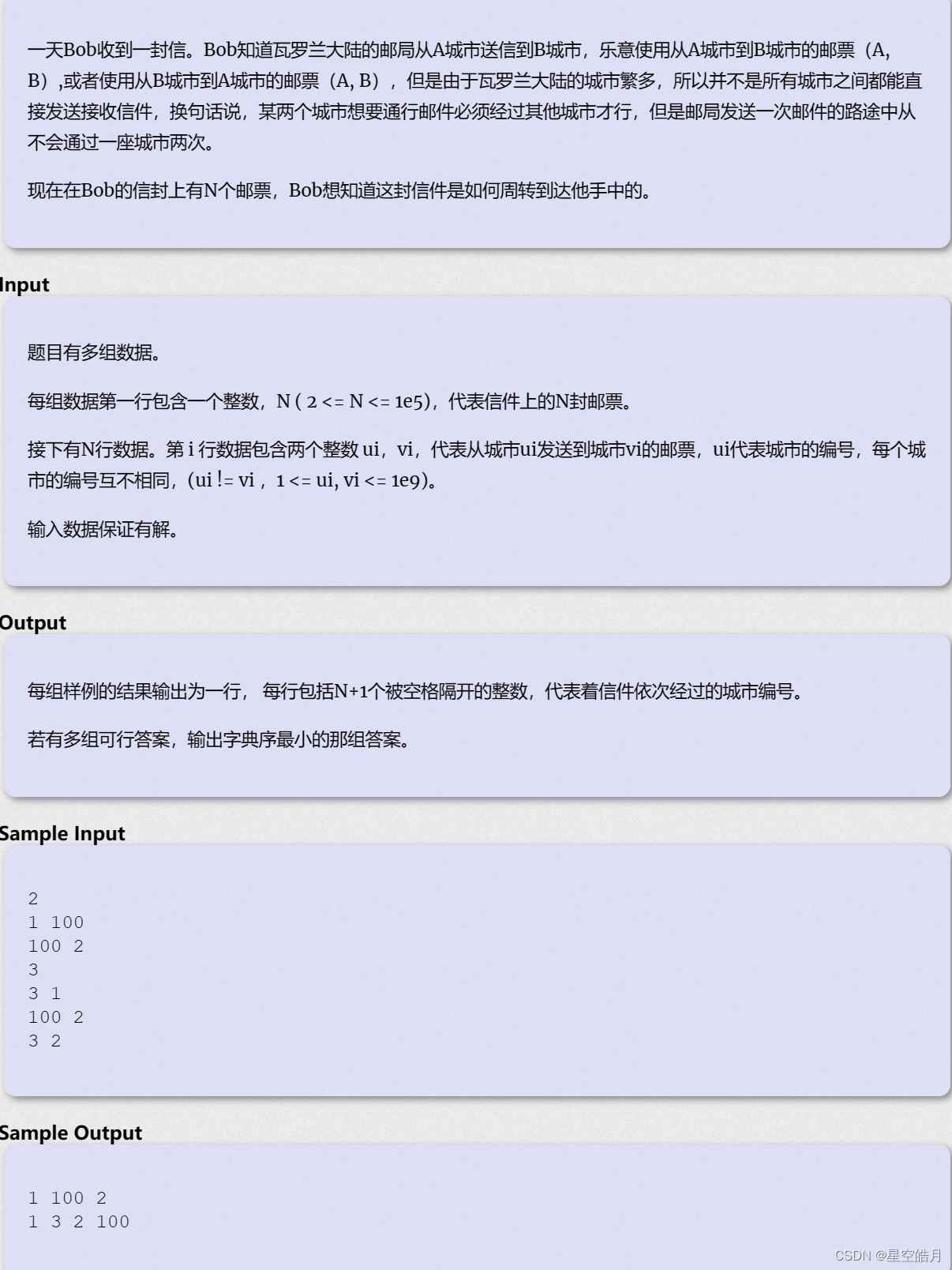
思路
可以先做映射关系(离散化),然后从最小的数并且这个数出现的次数为1开始dfs,走到哪直接就存到哪。
代码
#include<cstdio>
#include<vector>
#include<map>
#include<cstring>
using namespace std;
const int maxn=1e5+5;
map<int,int>index,data,num;
vector<int>v[maxn];//邻接表,存相对大小的关系
int cnt,pos;
int dis[maxn];
bool vis[maxn];
void dfs(int x)
{
if(cnt==pos) return;
//int len=v[x].size();
for(int i=0;i<2;i++) // 题目保证有解,说明一个顶点最多有两个出度
{
int y=v[x][i];
if(!vis[y])
{
vis[y]=true;
dis[pos++]=data[y];
dfs(y);
}
if(cnt==pos) return;
}
}
int main()
{
int n;
while(scanf("%d",&n)!=EOF)
{
int ui,vi;
cnt=0,pos=0;
index.clear();
data.clear();
num.clear();
memset(vis,false,sizeof(vis));
for(int i=0;i<2*n;i++) v[i].clear();
while(n--)
{
scanf("%d%d",&ui,&vi);
if(!num[ui])
{
index[ui]=cnt++;
data[index[ui]]=ui;//建立映射关系 (1,100) (100,1)
}
if(!num[vi])
{
index[vi]=cnt++;
data[index[vi]]=vi;
}
v[index[ui]].push_back(index[vi]);//建立相对大小的对应关系
v[index[vi]].push_back(index[ui]);
num[ui]++;
num[vi]++;
}
int st=0;
for(map<int,int>::iterator it=num.begin();it!=num.end();it++)
{
if(it->second==1) //判断是否唯一出现,第一个唯一出现的肯定是字典序最小且起始的位置
{
st=index[it->first];
break;
}
}
vis[st]=true;
dis[pos++]=data[st];
dfs(st);
for(int i=0;i<cnt;i++)
{
printf("%d",dis[i]);
if(i<cnt-1) printf(" ");
else printf("\n");
}
}
}
2.2 More is better HDU - 1856 【并查集】
题目描述
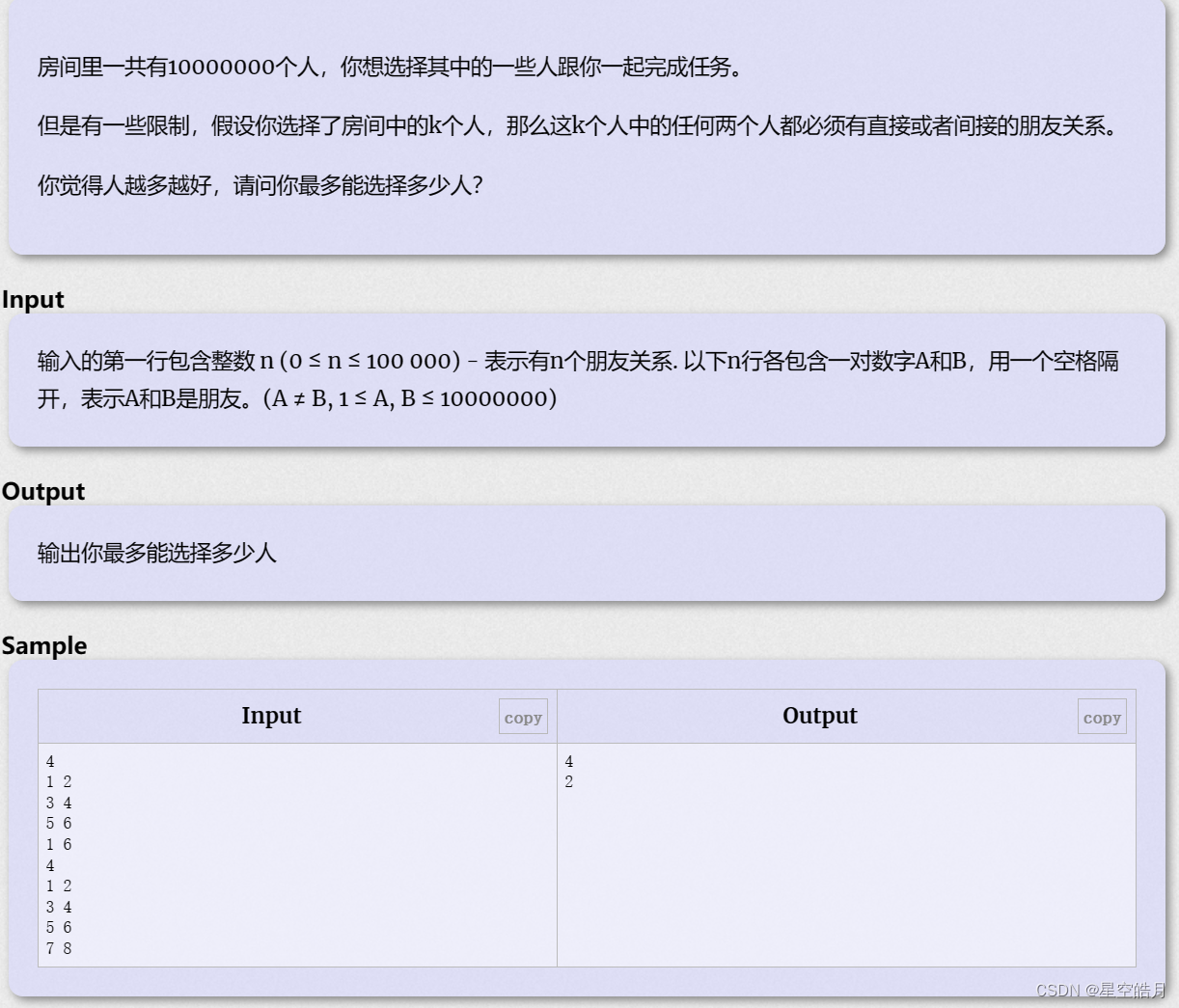
思路:
在集合合并的时,如果两个集合不同,那么在合并成同一个集合的时候,
将被合并的集合里的个数加到这个集合里面,并统计最大值。
坑点:就是当输入n为0时,答案为1,因为当没有朋友对时,各自在自己的房间,所以说答案为1。
代码:
#include<iostream>
#include<cstdio>
#include<map>
#include<utility>
#include<vector>
#include<algorithm>
using namespace std;
const int maxn = 1e5 + 5;
map<int, int> mp;
int fa[maxn], num[maxn], ans = 0;
void init(int n){
for (int i = 1; i <= n; ++i){
fa[i] = i;
num[i] = 1;
}
}
int find(int x){
return fa[x] == x ? fa[x] : fa[x] = find(fa[x]);
}
void _union(int x, int y){
x = find(x);
y = find(y);
if(x != y){
num[y] += num[fa[x]];
ans = max(ans, num[y]);
fa[x] = y;
}
}
void solve(){
int n, x, y;
while (scanf("%d", &n) != EOF){
int cnt = 0;
ans = 0;
init(maxn);
mp.clear();
if (n == 0){
puts("1");
continue;
}
while (n--){
scanf("%d%d", &x, &y);
if(!mp[x]) mp[x] = ++cnt;
if(!mp[y]) mp[y] = ++cnt;
_union(mp[x], mp[y]);
}
printf("%d\n", ans);
}
}
int main(){
solve();
return 0;
}
2.3 金发姑娘和 N 头牛 - 1952. AcWing题库
题目描述
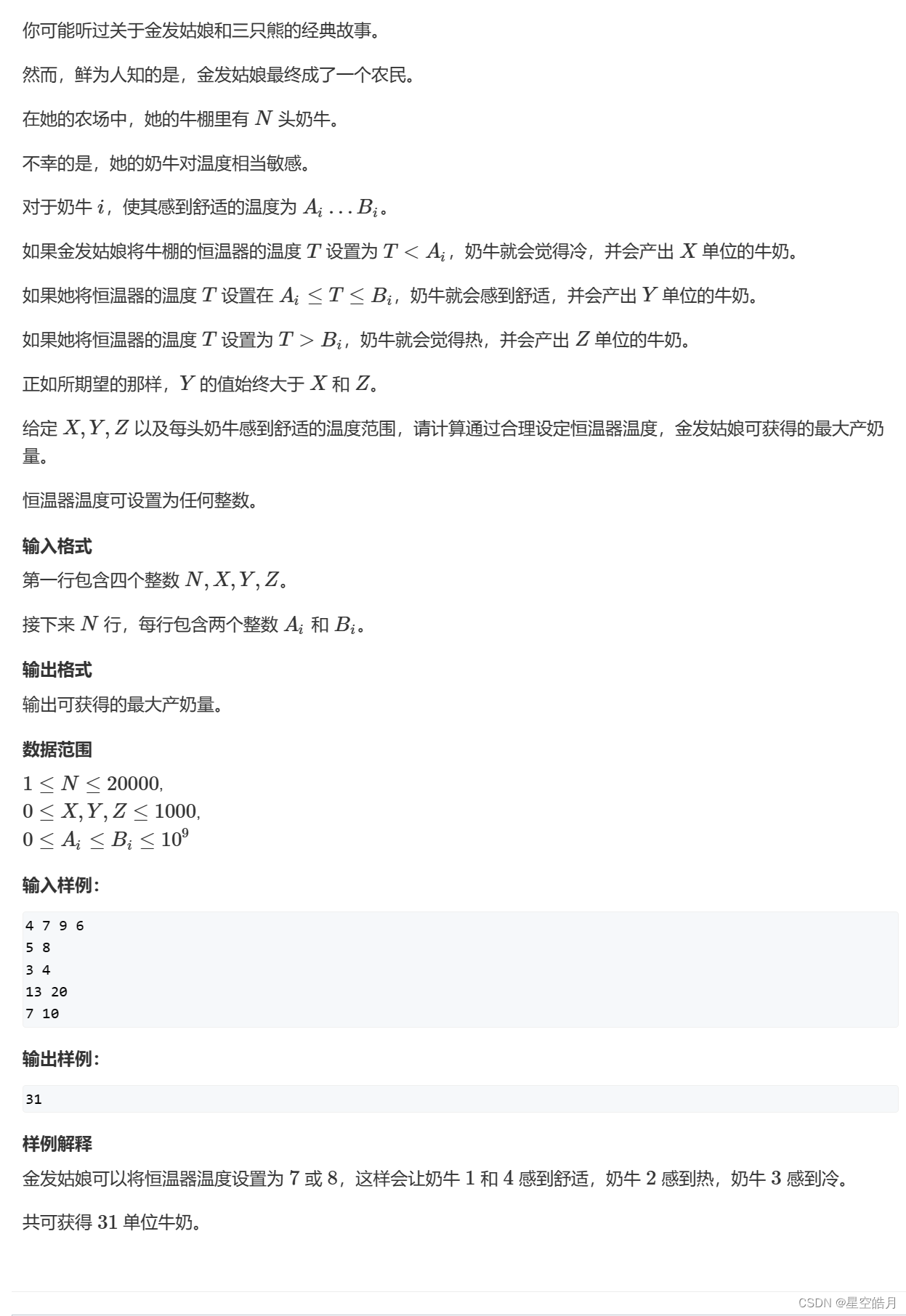
思路:

代码
#include <iostream>
#include <cstring>
#include <map>
#include <algorithm>
using namespace std;
const int INF = 2e9;
int n, x, y, z;
int main()
{
map<int, int> b; // 离散化及差分数组
cin >> n >> x >> y >> z;
for (int i = 0; i < n; i ++ )
{
//给三个大区间 + c
int l, r;
cin >> l >> r;
//[-INF,r)
b[-INF] += x;
b[l] -= x;
//[l, r]
b[l] += y;
b[r + 1] -= y;
//b(r, INF]
b[r + 1] += z;
b[INF] -= z;
}
int res = 0, sum = 0;
// 枚举差分数组,求前缀和,更新最大值
for(auto item : b)
{
sum += item.second;// 前缀和
res = max(res, sum);
}
cout << res;
return 0;
}

